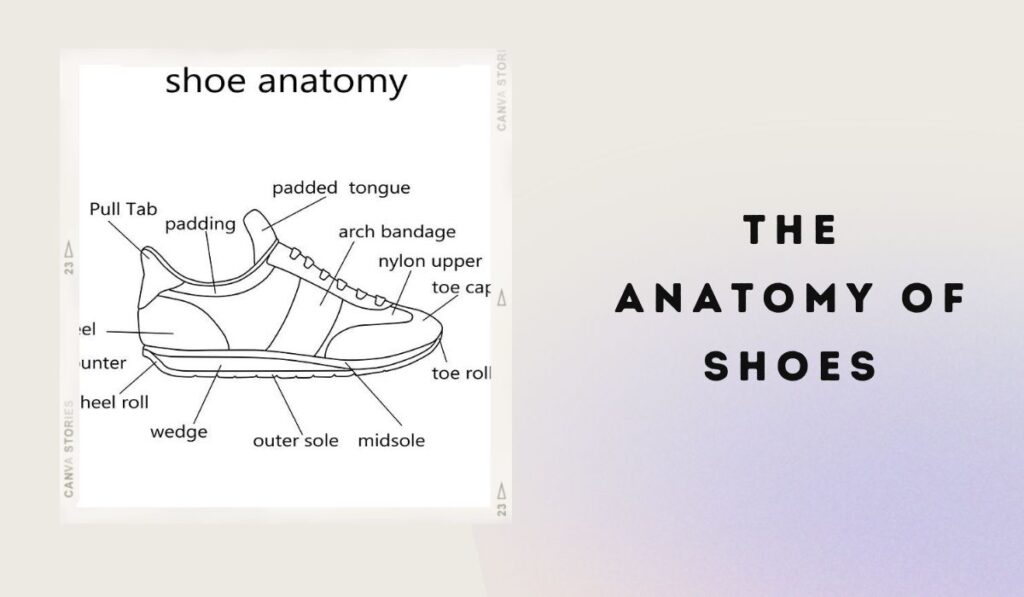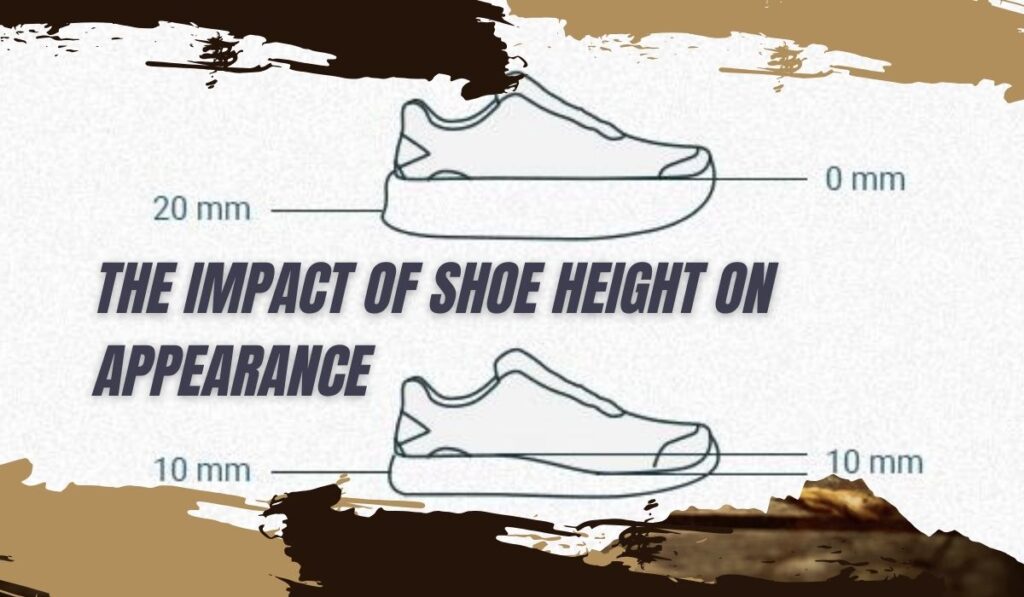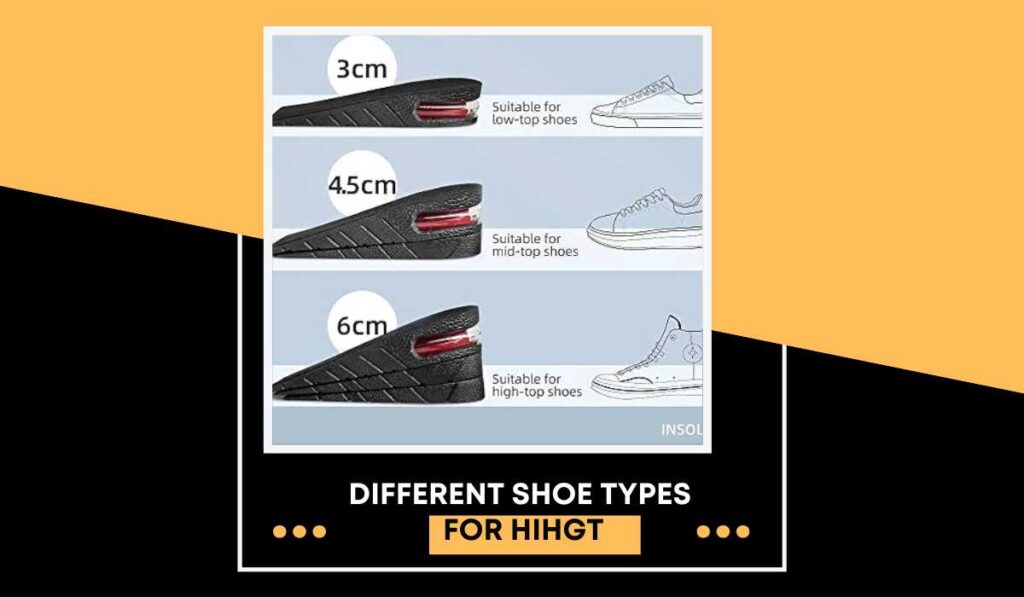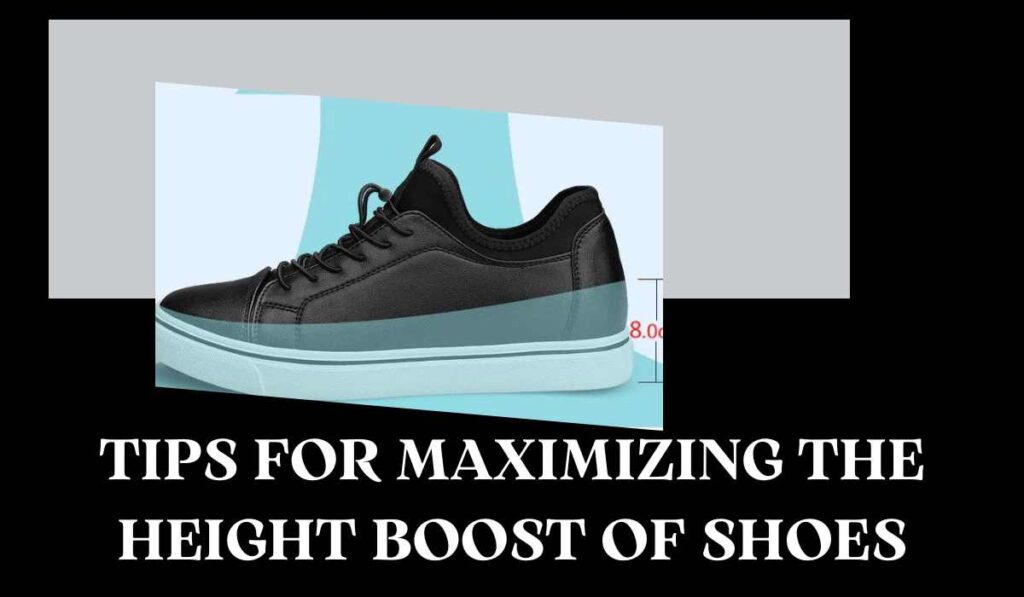Shoes typically add about 0.5 to 1 inch to a person’s height when worn. When we wear shoes, they provide some elevation between our feet and the ground, resulting in an increase in height.
This additional height can vary depending on the shoe type and the thickness of the sole. Some shoes, like high heels, can add even more height due to their elevated heels. The added inches can make a noticeable difference in a person’s overall stature and can contribute to a taller appearance.
Therefore, choosing the right shoes can be an effective way to enhance one’s height and create a taller silhouette.
Brief Overview of What the Post Will Cover
In this comprehensive blog post, we will explore every facet of shoe height, from the anatomy of shoes to the psychological effects of taller footwear. We will delve into the various components of shoes that contribute to height, explaining how elements like the outsole, insole, heel, and platform come together to create different levels of elevation. You’ll also learn how to measure shoe height accurately and understand the units of measurement involved.
We will discuss the visual impact of shoe height on your appearance, offering practical styling tips for different shoe heights and occasions. Furthermore, we will address the delicate balance between height and comfort, providing insights into choosing the right shoe height for various situations and maintaining foot health while wearing taller shoes.
Additionally, we’ll explore the cultural and historical perspectives on shoe height, shedding light on the evolution of elevated footwear and its significance in different societies. We’ll address common questions and misconceptions in a dedicated FAQ section and provide additional resources for those seeking more information or shopping recommendations.
By the end of this blog post, you’ll have a thorough understanding of how many inches shoes can add and the factors you need to consider when selecting the perfect footwear to suit your style, comfort, and confidence.
The Anatomy of Shoes

Components of a Shoe that Contribute to Height
Shoes are complex products composed of multiple components, each contributing to their overall height. These components include the outsole, insole, heel, and platform.
- Outsole: The outsole is the bottom part of the shoe that makes direct contact with the ground. It is typically made of rubber, leather, or synthetic materials and provides stability and protection. The thickness and design of the outsole can influence the overall height of the shoe, with thicker outsoles adding more elevation.
- Insole: The insole is the inner part of the shoe that provides cushioning and comfort for the wearer’s foot. While it doesn’t usually add significant height on its own, some specialized insoles, such as orthopedic or height-increasing insoles, are designed to offer additional elevation. These insoles are often used by individuals looking to increase their height discreetly.
- Heel: The heel is perhaps the most well-known component for adding height. It’s located at the back of the shoe and can vary in height from completely flat to several inches. Different types of heels, such as stilettos, wedges, or block heels, can affect the overall height and the wearer’s posture. High heels, in particular, are known for their ability to provide a significant height boost.
- Platform: Some shoes, especially high heels and boots, feature a platform in addition to the heel. The platform is a thickened sole under the ball of the foot that offsets the incline created by the heel. Platforms can add substantial height while providing better stability and comfort compared to heels of the same height.
How Each Component Affects Overall Height
Understanding how each shoe component affects overall height is crucial for making informed choices. The outsole primarily determines the baseline height of the shoe. A thicker outsole will naturally add more inches to your stature. The insole contributes to comfort but doesn’t usually add significant height unless you opt for specialized height-increasing insoles.
The heel, however, is the most prominent factor when it comes to increasing height. A higher heel will result in a greater overall height gain. Additionally, heels can influence posture, creating a more upright and elongated appearance. However, it’s essential to consider comfort and stability when choosing heel height, as extremely high heels may be challenging to walk in for extended periods.
Platforms work in conjunction with heels to provide height without an excessively steep incline. They distribute the wearer’s weight more evenly across the foot, making high heels more comfortable to wear. The combined height of the heel and platform determines the overall height increase.
Different Types of Shoe Designs and Their Height-Enhancing Features
Various shoe designs incorporate these height-enhancing components differently to cater to different style preferences and occasions. For example, high heels are often associated with formal and elegant footwear, while platform sneakers offer a more casual and sporty look with added height. Boots, especially knee-high or over-the-knee styles, frequently feature both heels and platforms, providing a considerable boost in stature while keeping the feet warm and stylish during colder seasons.
Understanding these different designs and their height-enhancing features allows individuals to choose shoes that align with their fashion preferences and comfort requirements. Whether it’s for a formal event or everyday wear, the choice of shoe design can significantly impact both your appearance and how you feel in your shoes.
Measuring Shoe Height
Techniques for Measuring Shoe Height
Accurately measuring shoe height is essential for individuals who want to know precisely how much height a particular pair of shoes adds. There are several techniques for measuring shoe height, depending on the level of detail and precision required.
One common technique is to measure the height from the bottom of the outsole to the highest point of the shoe, typically the top of the heel or platform. This method provides a straightforward measurement but may not account for variations in the shape or design of the shoe. Another technique involves measuring the distance from the insole’s highest point to the outsole. This approach can be more accurate, especially when dealing with shoes that have significant cushioning or thick insoles.
For those who want precise measurements, it’s possible to disassemble the shoe by removing the insole and measuring each component separately. While this method provides the most accurate results, it requires some deconstruction of the shoe and may not be suitable for all types of footwear.
Using a Ruler or Measuring Tape
To measure shoe height, you’ll need a ruler or a measuring tape. Here’s how to do it:
- Ruler: Place the shoe on a flat surface with the outsole facing down. Position a ruler vertically next to the shoe, aligning it with the back of the heel or the highest point of the shoe. Read the measurement where the top of the heel or platform touches the ruler. This measurement represents the height of the shoe.
- Measuring Tape: Similar to using a ruler, place the shoe on a flat surface and position the measuring tape vertically, aligning it with the highest point of the shoe. Carefully measure the distance from the bottom of the shoe (outsole) to the top of the heel or platform. This measurement gives you the shoe’s height.
It’s important to ensure that the shoe is positioned flat on the surface when measuring to get accurate results. Additionally, consider measuring both the left and right shoes separately, as slight variations in height can occur between pairs.
Understanding Units of Measurement (Inches, Centimeters, etc.)
Shoe height can be measured using various units of measurement, with inches and centimeters being the most commonly used. Understanding these units is crucial to interpreting measurements correctly.
In the United States and some other countries, shoe height is often expressed in inches. One inch is approximately equal to 2.54 centimeters. Therefore, when measuring in inches, you’ll get a measurement that reflects the shoe’s height in inches, such as 1 inch or 2.5 inches.
On the other hand, centimeters are the standard unit of measurement in many countries, including most of Europe and Asia. When measuring in centimeters, you’ll obtain a measurement in centimeters, such as 2.54 cm or 6.35 cm. To convert centimeters to inches, you can use the conversion factor of approximately 0.3937, which means that 1 centimeter is roughly equivalent to 0.39 inches.
Understanding both units allows you to compare and communicate shoe height measurements accurately, regardless of the unit of measurement used by the manufacturer or seller. This knowledge is valuable when shopping for shoes or discussing shoe height with others.
The Impact of Shoe Height on Appearance

How Taller Shoes Can Change Your Overall Look
The height of your shoes can have a profound impact on your overall appearance. Taller shoes, such as high heels or boots with heels, can create the illusion of longer legs and a taller stature. When you wear shoes that add height, it changes the way you carry yourself, making you stand more upright and altering your posture. This change in posture can make you appear more confident and self-assured.
Moreover, taller shoes can affect the proportions of your body, making you look slimmer and more elongated. For example, high heels can visually lengthen the legs, making them appear leaner and more toned. This optical trick can boost your confidence and enhance your self-esteem, which is one of the reasons many people opt for taller shoes, especially for special occasions or professional settings.
Understanding how taller shoes impact your appearance allows you to strategically use footwear to enhance your style, whether you want to create a more commanding presence, elongate your silhouette, or simply experiment with different looks.
Styling Tips for Different Shoe Heights
Styling shoes of varying heights requires a keen eye for fashion and an understanding of how different heights can complement your outfit. Here are some styling tips:
- High Heels: High heels are versatile and can elevate both formal and casual outfits. Pair them with dresses, skirts, or trousers to create a polished and sophisticated look. For a more casual vibe, consider wearing high-heeled sandals with jeans or shorts.
- Flats: Flat shoes, like ballet flats or sneakers, offer comfort and a more relaxed appearance. They pair well with jeans, casual dresses, and shorts, providing a balanced and effortless look.
- Ankle Boots: Ankle boots with low or medium heels can be styled with jeans, skirts, and dresses. They are a go-to choice for transitioning between seasons and can add a touch of edginess to your outfit.
- Knee-High Boots: These boots can be the focal point of an outfit. Pair them with dresses or skirts for a chic, sophisticated appearance, or with skinny jeans or leggings for a casual yet stylish look.
- Platform Shoes: Platforms can be styled for a bold fashion statement. Combine platform sandals with maxi dresses for a trendy summer look, or wear platform sneakers with athleisure outfits for a sporty, elevated appearance.
The Psychology of Height Perception
The psychology of height perception is a fascinating aspect of shoe height. Taller individuals are often perceived as more confident, authoritative, and successful. Therefore, wearing taller shoes can influence how others perceive you. It’s not just about physical height but the confidence and demeanor that often accompany it.
This phenomenon is sometimes referred to as the “height advantage” and has been observed in various social and professional contexts. People who feel more confident due to their elevated stature may find it easier to assert themselves in social interactions, job interviews, or public speaking engagements. It’s essential to recognize that this perception is not just about the actual inches added by shoes but the boost in self-esteem and perceived confidence that can come with them.
In conclusion, the height of your shoes goes beyond mere fashion; it can influence how you carry yourself, the way you are perceived by others, and your overall confidence. Understanding the impact of shoe height on your appearance and how to style different shoe heights can empower you to make intentional fashion choices that align with your personal style and goals.
The Importance Of Proper Shoe Fit
The Relationship Between Shoe Fit And Foot Health
Proper shoe fit is crucial to maintaining foot health and preventing various foot-related problems. Wearing shoes that are too tight, too loose, or simply ill-fitting can have a significant impact on the overall health and comfort of your feet. Let’s explore the key points that highlight the relationship between shoe fit and foot health:
- Support and stability: Shoes that fit properly provide the necessary support and stability to your feet. A snug fit ensures that your feet are held securely, preventing unnecessary pressure or strain on your muscles, tendons, and ligaments.
- Prevention of foot conditions: Wearing shoes that fit poorly can contribute to the development and aggravation of various foot conditions such as bunions, hammertoes, corns, and calluses. Proper shoe fit can help alleviate these issues and prevent them from getting worse.
- Proper alignment: Shoes that fit well help maintain the proper alignment of your feet and ankles, reducing the risk of imbalances and abnormalities. This alignment is essential for efficient movement and overall foot health.
- Circulation and breathing: Ill-fitting shoes can constrict blood circulation and limit the ability of your feet to breathe. This can lead to discomfort, swelling, and increased moisture levels, creating an ideal environment for fungal or bacterial infections. Proper shoe fit allows for optimal circulation and ventilation.
- Comfort and performance: Wearing shoes that fit correctly enhances your comfort and performance. By minimizing friction, pressure points, and discomfort, you’ll be able to walk, run, or engage in any physical activity with ease, reducing the risk of injury.
The Impact Of Wearing Ill-Fitting Shoes On The Feet
Wearing shoes that don’t fit properly can have detrimental effects on your feet. It’s essential to understand the consequences of wearing ill-fitting shoes and take the necessary steps to ensure proper shoe fit. Here are the key points to consider:
- Foot pain: Ill-fitting shoes can cause significant foot pain, ranging from mild discomfort to severe pain that affects your daily activities. This pain can be localized in specific areas such as the toes, arches, or heels, and can even radiate up the legs.
- Blister formation: Shoes that are too tight or rub against your skin can cause blisters to form. These painful fluid-filled pockets can lead to further discomfort and can potentially become infected if not treated properly.
- Ingrown toenails: Shoes that squeeze your toes or provide inadequate room can contribute to the development of ingrown toenails. This painful condition occurs when the edge of the toenail grows into the surrounding skin, leading to redness, swelling, and infection.
- Foot deformities: Prolonged wear of ill-fitting shoes can contribute to the development of foot deformities such as bunions, hammertoes, and flat feet. These conditions can cause pain, discomfort, and difficulties with mobility.
- Increased risk of falls: Shoes that don’t fit correctly can affect your balance and stability, increasing the risk of trips, slips, and falls. This is particularly important for older adults who may already have compromised balance and coordination.
By prioritizing proper shoe fit and taking the time to find footwear that suits your foot shape and size, you can significantly improve foot health, comfort, and overall well-being. Remember, the right shoes not only protect your feet but also support your entire body as you go about your daily activities.
Understanding Different Shoe Types And Their Effects On Height

How Different Styles Of Shoes Can Impact Height
Shoes not only serve the purpose of protecting our feet but also have the ability to enhance our overall appearance, including our height. Whether you’re looking to add a few extra inches or maintain your current height, it’s important to select the right shoe type.
In this section, we will explore how different styles of shoes can impact height, focusing on sneakers and high heels.
Sneakers
When it comes to sneakers, their impact on height is minimal. Here are the key points to consider:
- Sneakers generally provide a low to moderate heel height, typically around 0.5 to 1 inch.
- The key factor that affects height in sneakers is the cushioning and arch support, which may slightly elevate your heel and give the illusion of a slightly taller height.
- However, it’s important to remember that sneakers are designed for comfort and functionality rather than adding significant height.
High Heels
High heels are known for their ability to make us appear taller and more confident. Here are the key points to consider:
- High heels can add anywhere between 2 to 6 inches of height, depending on the heel height and platform.
- The heel height is the main factor that determines the increase in height.
- Additionally, the presence of a platform can further elevate your height by reducing the angle between your foot and the ground.
- It’s important to note that prolonged use of high heels can put excessive strain on your feet, so it’s advisable to take breaks and wear comfortable footwear when needed.
Boots
Boots come in various styles, and their height-enhancing properties can vary accordingly. Ankle boots typically have a low heel or none at all, adding minimal height. However, knee-high and over-the-knee boots often feature heels that can range from a few inches to several inches. These tall boot styles can provide a significant boost in height while keeping your legs warm and stylish during colder seasons.
Platform boots are another option for those seeking substantial height. They combine a raised sole (platform) with a heel, resulting in a combination that can add several inches to your overall stature. The choice of boots largely depends on the occasion, personal style, and desired height increase.
Sandals
Sandals, known for their comfort and breathability, typically have flat or low heels. They are not primarily designed for height enhancement but rather for ease of wear in warm weather. However, some sandal styles may feature a small wedge or platform sole, adding an inch or so in height. These sandals are suitable for individuals who want a bit of elevation without compromising on the relaxed and casual feel of sandals.
Athletic Shoes
Athletic shoes, including running shoes and sneakers designed for sports, often have a cushioned sole for comfort and shock absorption. While they are not typically associated with height enhancement, some athletic shoe models may feature a slightly thicker sole or midsole, resulting in a subtle increase in height. The height gain in athletic shoes is usually minimal, with most designs prioritizing performance and support over added elevation.
Formal Shoes
Formal shoes encompass a wide range of styles, from oxfords to loafers and derbies. The height-adding properties of formal shoes depend on the specific design and heel type. For example, dress shoes like oxfords and derbies usually have a moderate heel, typically around 1 to 2 inches, which can provide a subtle height increase suitable for formal occasions.
Loafers, on the other hand, may have a flat or low heel and are generally not intended to add significant height. However, some formal shoe styles come with hidden wedges or platform soles to discreetly boost height while maintaining a polished appearance.
Shoe Height and Comfort
The Trade-off Between Height and Comfort
When it comes to shoe height, there’s often a trade-off between added inches and comfort. Taller shoes, particularly those with high heels or significant platforms, can alter the natural alignment of the foot and put extra pressure on certain areas. This can lead to discomfort, pain, and even long-term foot problems if not managed properly. It’s crucial to strike a balance between height and comfort, as wearing excessively tall shoes for extended periods can cause issues like bunions, metatarsalgia, or plantar fasciitis.
Understanding your own comfort threshold is essential. Some individuals can comfortably wear high heels for hours, while others may find even moderate heel heights uncomfortable. Factors such as the shoe’s design, cushioning, and arch support also play a role in comfort. It’s advisable to prioritize shoes that provide adequate support and cushioning, especially if you plan to wear them for an extended period.
Choosing the Right Shoe Height for Different Occasions
Selecting the right shoe height for various occasions is key to both comfort and appropriateness. Here are some guidelines:
- Everyday Wear: For daily activities, consider shoes with moderate or low heel heights or opt for flats or sneakers. These choices offer comfort and support, making them suitable for long hours of wear.
- Formal Events: When attending formal events like weddings or galas, you may want to wear higher heels or dress shoes to elevate your look. However, choose a heel height that you’re comfortable with and that allows you to stand and walk confidently.
- Work: In a professional setting, opt for shoes that strike a balance between style and comfort. Medium-height heels or comfortable wedges can add sophistication without sacrificing comfort during long workdays.
- Casual Outings: Casual outings call for shoes that match your style and the activities you have planned. Choose footwear that suits the occasion, whether it’s flat sandals for a beach day or ankle boots with a low heel for a coffee date.
Tips for Maintaining Foot Health While Wearing Taller Shoes
To maintain foot health while wearing taller shoes, consider the following tips:
- Proper Sizing: Ensure your shoes are the right size and provide ample room for your toes. Ill-fitting shoes can lead to discomfort and foot problems.
- Arch Support: Look for shoes that offer good arch support, especially if you’re wearing heels. Inserts or custom orthotics can also provide additional support.
- Gradual Transition: If you’re not accustomed to wearing high heels or taller shoes, start with lower heights and gradually increase as your feet adjust to the change in elevation.
- Stretching Exercises: Perform foot and calf stretching exercises to prevent muscle tightness and reduce the risk of conditions like Achilles tendonitis.
- Rest and Elevation: After wearing taller shoes for an extended period, give your feet some rest and elevate them to reduce swelling and pressure.
- Choose Quality Shoes: Invest in well-constructed shoes made from high-quality materials. Quality shoes tend to provide better support and last longer.
In conclusion, the relationship between shoe height and comfort is a critical consideration when choosing footwear. Prioritizing comfort doesn’t mean sacrificing style, as there are plenty of stylish options available that also provide support and comfort. By understanding the trade-off between height and comfort, selecting the appropriate shoe height for different occasions, and following foot health tips, you can enjoy fashionable footwear without compromising the well-being of your feet.
Factors That Determine The Height Increase By Shoes

Understanding the factors that determine how many inches shoes add to your height can help you choose the right footwear that fits your needs. While it’s true that adding height to your stature is often associated with confidence and attractiveness, it’s important to consider several factors that can influence your overall height increase.
Let’s explore some key factors that play a role in determining how many inches shoes can add to your height.
The Influence Of Heel Height On Added Inches
The heel height of your shoes can significantly impact the additional inches you gain in height. Here are a few important points to consider:
- Higher heel heights generally provide more height enhancement, as they elevate your feet further off the ground.
- Stiletto heels, for example, can add several inches to your height due to their substantial lift.
- Chunky heels or wedges can also offer a significant height boost, though it may not be as dramatic as with stiletto heels.
- The added height is contingent on your ability to maintain balance and walk comfortably in higher-heeled shoes. Practice and adaptation are key to ensuring both comfort and stability.
Platform Shoes And Their Height Enhancement
Platform shoes are known for their distinctive thick soles and can provide substantial height enhancement. Here are a few notable points:
- Platform shoes typically have a higher sole thickness at the front compared to the back, resulting in a slope-like design. This design adds extra height to your overall stature.
- The thickness of the platform sole directly correlates with the amount of height gain. The thicker the sole, the greater the additional inches you’ll achieve.
- Platform shoes often offer a more stable and balanced walking experience compared to high-heeled shoes due to the even distribution of weight across the foot.
Does Shoe Insole Thickness Affect Height Gain?
The thickness of shoe insoles can have an impact on the height increase achieved. Consider the following points:
- Shoe insoles, commonly known as inserts or lifts, are removable inserts placed inside the shoe to provide additional height.
- The greater the thickness of the insole, the more height you can gain. However, it’s crucial to find the right balance between comfort and height gain.
- Insoles that are too thick may compromise the shoe’s fit, resulting in discomfort and potential foot-related issues. It’s essential to choose insoles that offer both height enhancement and proper support.
To conclude, understanding the various factors that affect the height increase by shoes is crucial when it comes to selecting the right footwear. The heel height, platform shoes, and shoe insole thickness all contribute to the additional inches you can achieve.
By considering these factors and finding a balance between comfort, stability, and style preferences, you can confidently choose shoes that best suit your height enhancement needs.
Debunking Myths About Shoe Height Enhancement
Are you curious about how many inches shoes can add to your height? Wondering if shoe lifts or elevator shoes actually work? In this section, we’ll separate fact from fiction and debunk some common myths surrounding shoe height enhancement.
Do Elevator Shoes Actually Add Inches?
Many people believe that elevator shoes can significantly increase their height. Let’s take a closer look at the truth behind this popular myth:
- Elevator shoes, also known as height-increasing shoes or platform shoes, are designed with built-in lifts to add extra height to the wearer.
- These shoes typically have a discreetly hidden higher heel and elevated insoles, providing a subtle boost in height.
- While elevator shoes can indeed add some inches, it’s important to note that the actual height increase varies depending on the design and construction of the shoe.
- On average, elevator shoes can provide an additional height of 1 to 3 inches.
- However, it’s crucial to select the right size and style to ensure a comfortable fit and natural-looking height enhancement.
- It’s worth mentioning that elevator shoes are not a magical solution that will instantly transform your appearance. They are simply a fashion choice that can offer a modest height increase.
Separating Fact From Fiction: Understanding Shoe Lifts
Shoe lifts, also known as height-increasing insoles or inserts, can be another option for those looking to add a few extra inches to their height. Here are some key points to help you understand shoe lifts better:
- Shoe lifts are removable inserts that can be placed inside your regular shoes to add height.
- These inserts often consist of multiple layers or adjustable pads, allowing you to customize the height increase according to your preference.
- Unlike elevator shoes, shoe lifts can be used with various types of footwear, giving you more flexibility in your style choices.
- Shoe lifts are designed to provide a discreet height boost, with the actual increase ranging from 0.5 to 2 inches.
- They are generally made of lightweight and durable materials, ensuring comfort and support throughout the day.
- Shoe lifts offer a non-permanent solution to height enhancement, allowing you to remove them whenever you prefer to go back to your regular shoe height.
Can Shoe Inserts Really Increase Your Height?
Shoe inserts, like gel heel pads or arch support inserts, serve a different purpose than elevator shoes or shoe lifts. They are primarily designed to enhance foot comfort rather than adding height. Here’s what you need to know about shoe inserts:
- Shoe inserts can provide additional cushioning, support, and stability, alleviating discomfort associated with specific foot conditions or physical activities.
- While shoe inserts may enhance your overall comfort and possibly correct certain foot issues, they do not function as height-increasing devices.
- These inserts are available in various forms, from simple gel pads to custom orthotics, catering to different foot needs and preferences.
- If you’re looking for height enhancement, it’s better to explore elevator shoes or shoe lifts, as these are specifically designed for that purpose.
Remember, understanding the facts about shoe height enhancement can help you make informed decisions about the tools you choose to give you that extra boost. Whether it’s elevator shoes, shoe lifts, or shoe inserts, find the option that suits your needs and style while keeping comfort as a priority.
Tips For Maximizing The Height Boost Of Shoes

It’s no secret that shoes can add a few extra inches to your height, giving you a confidence boost and making you feel taller. If you’re looking to maximize the height gain from your shoes, here are some tips to keep in mind:
Choosing The Right Shoe Size And Style For Optimal Height Gain:
- Start by getting your feet measured by a professional. Wearing the right shoe size is crucial for comfort and maximum height gain.
- Look for shoes with a slightly higher heel or sole. Even a small increase in height can make a noticeable difference.
- Consider elevator shoes or height-increasing inserts that are specifically designed to provide an added boost to your height.
- Opt for shoes with a pointed toe or a low-profile design. These styles can create an illusion of longer legs, making you appear taller.
- Avoid bulky or chunky footwear, as they can make your feet look larger and shorten the appearance of your legs.
Pairing Shoe Height Enhancers With Confidence-Boosting Outfits:
- Wear pants that cover the top part of your shoes. This will create a seamless look and help maintain the illusion of added height.
- Opt for monochromatic outfits or ones with vertical stripes. These patterns create a visual elongation of the body, making you appear taller.
- Choose well-fitted clothing that flatters your body shape. Baggy or ill-fitting clothes can make you look shorter and overwhelm the height boost provided by your shoes.
- Experiment with different layers and proportions. Adding layers and playing with proportions can create an illusion of height and make you appear taller.
Proper Posture And Walk: Making The Most Of Your Height
- Stand tall and maintain good posture. Keep your shoulders back, chin up, and engage your core muscles. Good posture not only makes you look taller but also exudes confidence.
- Walk with purpose and in a confident manner. Avoid slouching or shuffling your feet. A strong, confident stride can enhance the overall impact of your increased height.
- Practice exercises that improve posture and flexibility. Yoga, pilates, or regular stretching routines can help strengthen your core muscles, improve posture, and make you stand taller.
By following these tips, you can make the most out of your shoes and get that maximum height boost you desire. Remember, confidence is key, and when you feel good about yourself, it will radiate from within. So, put on your favorite pair of height-enhancing shoes, rock your outfit, stand tall, and step out with confidence!
Conclusion: The Impact Of Shoes On Height And Confidence
The Importance Of Wearing Properly Fitted Shoes
Wearing properly fitted shoes is crucial for both your overall comfort and your foot health. Ill-fitting shoes can cause various foot problems, including bunions, corns, calluses, and blisters. Here are the key points to consider:
- Correct sizing: Properly fitting shoes should have enough room for your toes to move comfortably while providing a snug fit around the heel and arch. It’s important to measure your feet regularly, as shoe sizes can vary between brands.
- Arch support: Shoes with adequate arch support help maintain the natural alignment of your feet, reducing the risk of developing conditions such as plantar fasciitis or fallen arches.
- Proper weight distribution: Shoes that fit well distribute your body weight evenly across your feet, preventing pressure points and reducing the likelihood of foot pain or discomfort.
- Improved posture: Wearing shoes that fit properly can positively impact your posture, as they contribute to a stable and balanced gait. This, in turn, can alleviate strain on your joints and muscles.
Balancing Style And Height Enhancement
When it comes to choosing the right shoes, it’s essential to find a balance between style, comfort, and height enhancement. Here are some key considerations:
- Style: Shoes play a significant role in personal style and can boost confidence. It’s important to choose shoes that not only fit well but also align with your personal fashion choices.
- Height enhancement: Many individuals are curious about the height-increasing effects of certain shoes. While shoes with built-in height-boosting features exist, such as platform shoes, it’s important to choose comfortable options that don’t compromise your foot and ankle health.
Wearing properly fitted shoes is crucial for both your foot health and confidence. Finding the right balance between style, comfort, and height enhancement allows you to rock your shoes with confidence while ensuring optimal foot support and overall well-being. Remember to always prioritize proper sizing, adequate arch support, and even weight distribution to maintain foot health and posture.
With the right shoes on your feet, you’ll stride through life with confidence and style.
Frequently Asked Questions For How Many Inches Do Shoes Add
How Many Inches Do Shoes Add To Your Height?
Shoes generally add around 1 to 2 inches to your height, depending on the type and style of the shoe. Height-enhancing shoes or inserts may provide more height. Keep in mind that the added height is temporary and varies based on various factors such as shoe design, sole thickness, and personal posture.
Do Shoe Lifts Make You Taller?
Yes, shoe lifts can make you appear taller by adding extra height to your shoes. These inserts are designed to fit discreetly inside your shoes and can provide a noticeable height increase. However, it’s important to note that shoe lifts only add temporary height and won’t actually change your physical stature.
Which Types Of Shoes Provide The Most Height?
Shoes with thick soles, like platform shoes or sneakers with built-in heels, can provide more height compared to regular shoes. Elevator shoes, which have hidden height increase features, are also specifically designed to provide additional height. Choose shoes with larger heel heights or added cushioning to maximize your height gain.
Conclusion
The height-boosting abilities of shoes have a significant impact on how we perceive ourselves and how others perceive us. Understanding the additional inches that shoes provide can lead to increased confidence and a more positive self-image. Whether it’s for special occasions or everyday wear, having the knowledge of how much height shoes can add allows us to make informed decisions when it comes to selecting our footwear.
Moreover, being mindful of the comfort and fit of our shoes is important to ensure that we can enjoy the added height without sacrificing our overall well-being. By considering factors such as heel height, insole thickness, and shoe style, we can find the perfect balance of style and comfort.
So, next time you slip on a pair of shoes, remember that they’re not just an accessory – they have the power to make us stand tall, both literally and figuratively.


